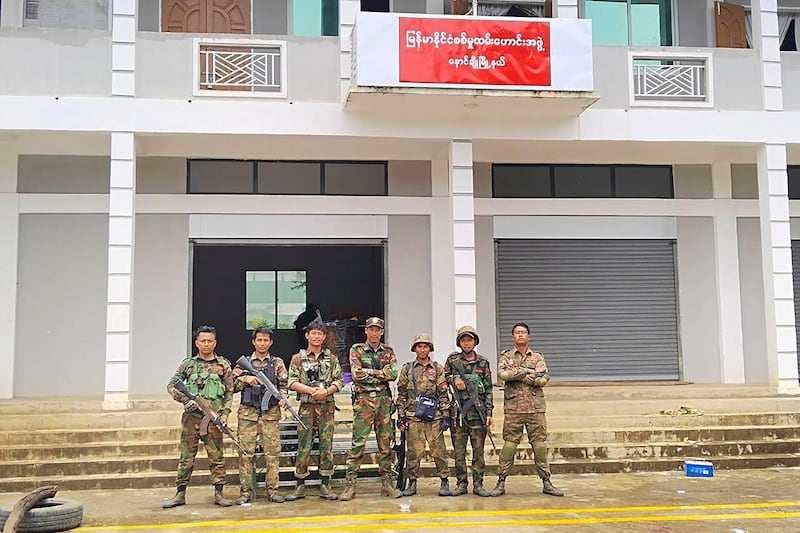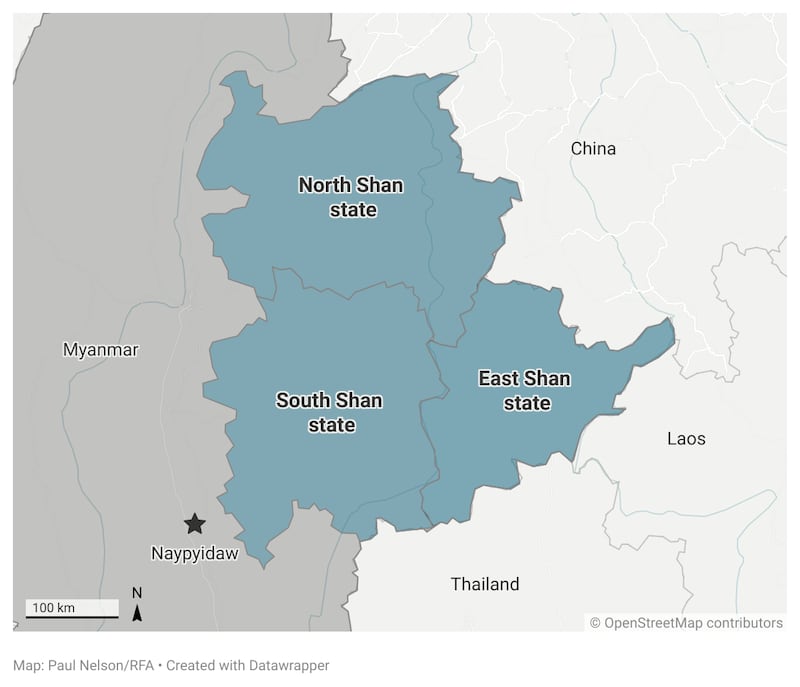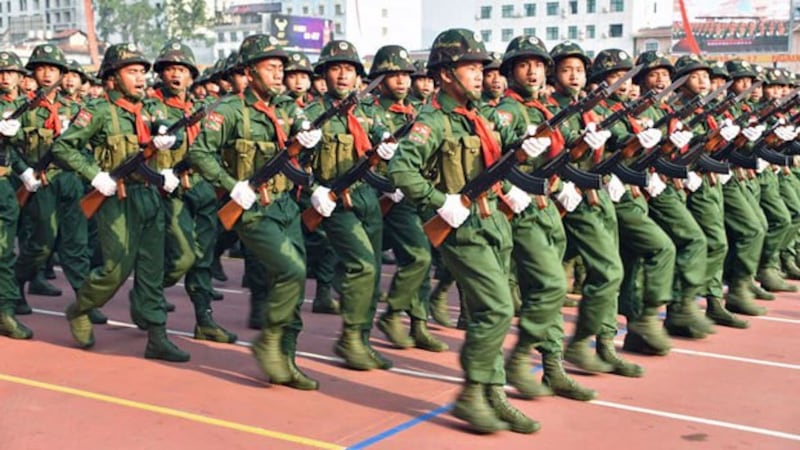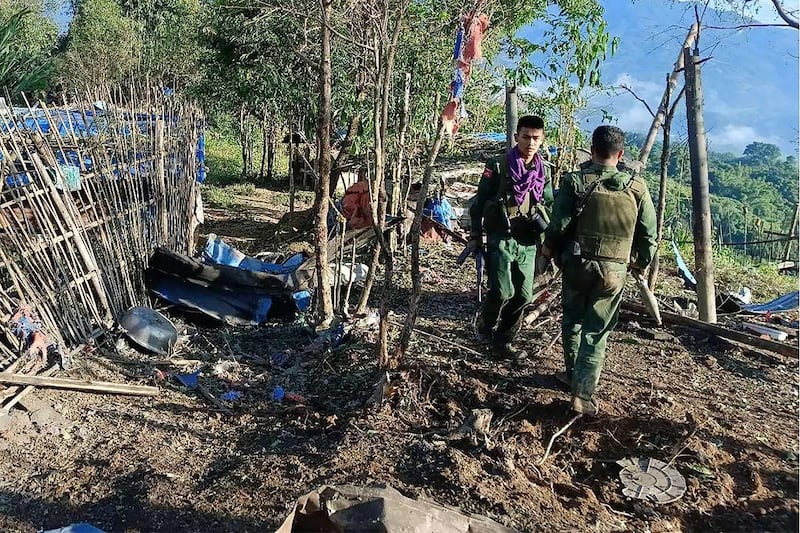The rout of military junta troops and seizure of territory across Myanmar’s border with China has brought the Three Brotherhood Alliance a new struggle in Shan state: dealing with a myriad of actors and shifting alliances seeking to profit from the rapidly changing political landscape.
The region’s multiple well-armed ethnic armies include a powerful force that is a de facto ally of Beijing, groups that are aligned with the junta, and other militias with no allegiance to the democratic opposition National Unity Government or the fight to reverse the 2021 military coup.
In northern Shan state, insurgent alliance members the Ta’ang National Liberation Army (TNLA) and the Myanmar National Defense Alliance Army (MNDAA) last month launched the second phase of Operation 1027, capturing key military outposts in the country’s largest state.
The TNLA's capture of the last junta camp in Nawnghkio, and its move south into Mogok, will complicate the movement of reinforcements and resupply of Lashio, northern Shan state's biggest city and a commercial gateway between Mandalay and Muse on the Chinese border.

China has put pressure on the alliance to halt the offensive, which started after violations of a cease-fire China negotiated in January. On July 13, the MNDAA announced a unilateral cease-fire would go into effect from July 14-18, out of respect for the Chinese Communist Party, which was convening a Third Plenum session in Beijing,
While the two forces remain in positions around Lashio, their offensive has slowed for now. That’s not to say that hostilities have ceased: The junta continues to launch airstrikes.
China has been unable to broker a new ceasefire, even though the Three Brotherhood Alliance had sent representatives to nearby Kunming for talks.
The MNDAA and TNLA always fight back in self-defense. And with their newly captured Chinese-made anti-aircraft artillery, the two Shan state-based armies have more capacity to target the heavy-lift Mi-17 helicopters the junta uses to resupply and reinforce remote positions.
RELATED STORIES
[ Myanmar rebels rack up more gains as Operation 1027 enters new phaseOpens in new window ]
[ Myanmar insurgent allies capture strategic Shan state town from juntaOpens in new window ]
[ Ethnic army overruns junta command center in Myanmar’s Kokang regionOpens in new window ]
[ China awaits junta approval to resume border trade with Myanmar’s Shan stateOpens in new window ]
Inroads into Shan regions
The turmoil in Shan state has drawn local actors – the United Wa State Army (UWSA) and Shan State Progressive Party (SSPP) – off the sidelines. They are trying to limit the Brotherhood’s gains and exploit the weakness of the State Administrative Council, as the junta is formally known.
Tensions between the TNLA and SSPP continue to fester, with both sides accusing the other of instigating attacks.
July 13 talks between the two sides in Panghsang aimed at lowering tensions were declared successful by the TNLA.
But while these have not escalated into a larger conflict, they’ve resulted in the SSPP not joining the fight against the junta. Indeed, the SSPP, along with the UWSA, seem to be abetting the junta.
What we are seeing play out are ethnic loyalties and alliances in the complex Shan patchwork. At over 155,000 square kilometers 60,000 square miles), Shan state is not just the largest of Myanmar’s 14 states and administrative divisions, it makes up nearly a quarter of the total land area.
The majority of the six million population are ethnic Shan, with nine other ethnic groups. The TNLA represents the roughly half a million Ta’ang, or Palaung people. The MNDAA is comprised of Mandarin-speaking ethnic Chinese based on the border with China’s Yunnan province.
As a result of Operation 1027, the two Brotherhood armies are making significant inroads into ethnic Shan-dominated regions.

The state has several ethnic resistance organizations composed of ethnic Shan, including the SSPP and the Restoration Council of Shan State (RCSS).
But they are bitter rivals and with limited manpower, equipment, and resources, and neither army controls a contiguous area, making a political map of central and southern Shan State look like a patch of leopard spots.
Most of the armed groups in the region have been highly opportunistic and unprincipled. None joined the National Unity Government or picked up arms against the regime.
All three groups have benefited from the insecurity caused by the coup, which allowed them to focus on their illicit business activities, including the production, sale, and/or taxation of methamphetamine.
The Wa: rested and ready
After Operation 1027 began last October 27, the SSPP attacked its rival the RCSS, on the grounds that it remained a National Ceasefire Agreement partner of the junta. While it was hoped that the SSPP would join Operation 1027, their limited operations against the junta’s ally last year was accepted as sufficient for the time being.
The SSPP seemed to pledge support for the second phase of Operation 1027, but its tensions with the TNLA have put that on hold.
In a surprise move, the United Wa State Army has started to move well outside of its Wa autonomous region, centered on the border crossing to China at Panghsang (Pangsang).
The UWSA captured the mountain town of Tangyan, which is 135 km (85 miles) south of Lashio, without firing a shot, then continued west and took Mongyai.
There are now reports that the UWSA have moved west all the way to the Salween (Thanlyin) River – leading observers to ask, what’s going on?
With 20-30,000 men, the UWSA, which grew out of the wreckage of the Communist Party of Burma, is one of the largest and best armed ethnic resistance organizations. Ostensibly an ethnic Wa organization, today its leaders are all Mandarin-speaking ethnic Chinese, and the group is seen as Beijing’s closest proxy. They’ve had autonomy since 1989.

The Wa have been neutral in the Spring Revolution anti-coup movement, neither condemning the coup nor joining the opposition, though they’ve been an important source of weapons for the opposition movement.
The UWSA facilitated the withdrawal of regime forces from MNDAA-captured territory following the launch of Operation 1027 and maintains ties with the junta.
Having sat out the three-year uprising against the junta, Wa forces are fresh and well armed. If any organization is poised to take advantage of a rapidly changing security landscape, it’s the opportunistic Wa.
Keeping lifeline to China
The capture of Tangyan and Mongyai raise many questions about the UWSA’s motivations.
While there is a possibility that the UWSA is simply trying to seize territory to expand its footprint, their actions this time seem more calculated. UWSA has operated in concert with the SSPP and in apparent agreement with the junta.
Traditionally, the UWSA and the SSPP have been close, and the SSPP’s offensive against its rival the RCSS was only possible with UWSA support.
Tangyan town is well outside of the Wa’s territory and an area traditionally under the influence – though not administrative control – of the SSPP.
Some have surmised that Tangyan was taken to preempt further conflicts between the TNLA and SSPP, after the TNLA had attacked a number of military posts on the outskirts of the town.
The UWSA made a cursory statement to that effect saying that they were “invited” into the town as a “preventative measure”.
The junta either approved the operation or was in no position to stop it; better the city be taken by the Wa than the TNLA. Likewise, the SSPP now appears to be in administrative control of Mongyai.
There are mixed reports whether the military has fully withdrawn its troops or has maintained some administrative presence in both towns.
Regardless, the UWSA now serves as a bulwark preventing the Three Brotherhood Alliance from moving any further south.
The UWSA also has an important economic rationale, one China shares.

Given the Three Brotherhood Alliance’s control of Chinshwehaw and the highway to Muse (though not the town itself), and the Kachin Independence Army’s control of all border crossings in their state, border trade with China has dried up.
While Panghsang is not a major border crossing due to the mountainous terrain and isolation, the city of 50,000 people is one of the only crossings to China accessible to the junta. Mongyai and Tangyan sit on the sole, small road to China.
It is likely that Beijing gave the UWSA the green light to move out of its territory in order to maintain a land bridge to the increasingly isolated junta and block any further Three Brotherhood Alliance gains.
Zachary Abuza is a professor at the National War College in Washington and an adjunct at Georgetown University. The views expressed here are his own and do not reflect the position of the U.S. Department of Defense, the National War College, Georgetown University or Radio Free Asia.
